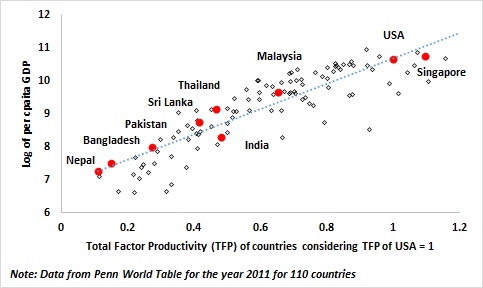The theoretical and empirical literature on sources of economic growth emphasized on factor accumulation and factor productivity as two major sources of growth. Though factor accumulation can explain a significant part of economic growth, it can’t explain the sustained long-run economic growth, as sustained long-run economic growth is attributable to growth in productivity. Productivity is the cornerstone of economic growth. Increases in productivity allow firms to produce greater output for the same level of input and thus result in higher Gross Domestic Product (GDP).
We should make clear the difference between labor productivity, which is output per worker, and Total Factor Productivity (TFP), which is the ‘ability’ with which all factors are combined to produce outputs. TFP is the part of the output that is not explained by the number of inputs used in production. Essentially, its level is determined by how efficiently and intensely the inputs are used in the production process. TFP growth is usually measured by the Solow residual. TFP plays a key role in economic fluctuations, economic growth and cross-country differences in per capita income.
The scatter-plot using the data for 110 countries in 2011 shows a very interesting association between TFP and log of per capita GDP. The TFP data are derived from the Penn World Table version 8.1 (PWT 8.1) with some required adjustments and extensions. Here the TFP level of USA is considered as 1 and other countries’ TFP levels are indexed against USA’s TFP level. For example, among the South Asian countries, the TFP levels of Bangladesh, India, Nepal, Pakistan and Sri Lanka in 2011 were 0.15, 0.48, 0.11, 0.28 and 0.42 respectively. Similarly, TFP levels of Malaysia and Thailand were 0.47 and 0.65 respectively. Singapore’s TFP level (1.1) was higher than that of the USA. The trend line shows a very strong positive association between TFP and log of per capita GDP (the correlation coefficient is 0.9). Nepal and Bangladesh, though on the trend line, are at the lower end of the association. A straightforward policy suggestion for these countries is that a rise in the TFP level is required to raise their per capita GDPs.

Why do countries differ in TFP? How to improve the level of TFP? In order to answer these questions, we have run fixed effect cross-country panel regressions for 110 countries for the period 1995-2011 considering log of TFP as the dependent variable. The explanatory variables include log of human capital (an index of human capital per person which is linked to the average years of schooling and the return to education), log of public expenditure on health as % of GDP, and log of trade-GDP ratio. The data source of human capital is the PWT 8.1, and the data on health expenditure and trade-GDP ratio are taken from the World Bank WDI. The logic behind the formulation of this model is that we want to explore how cross-country differences in statuses of education, health, and openness affect the cross-country differences in the TFP. The regression results suggest that all three explanatory variables are statistically significant with expected signs. 1% rise in the human capital index is associated with 0.39% rise in the TFP. Also, 1% rise in the ratio of public health expenditure to GDP is associated with 0.03% rise in the TFP. Finally, 1% rise in the trade-GDP ratio is associated with 0.03% rise in the TFP.
In extended models, we have found that the ratio of FDI to GDP is positively and significantly associated with the TFP. 1% increase in the FDI-GDP ratio is associated with 0.01% rise in the TFP. Furthermore, institutional variables like bureaucracy quality and investment profile (from the PRS database) are positively associated with the TFP with statistical significance. Improvements in the bureaucracy quality and investment profile by one unit are associated with the rise in TFP by 0.03% and 0.01% respectively.
The aforementioned analyses point to some very obvious policy suggestions. Countries like Bangladesh need to attach decisive emphasis on improving their currently low levels of human capital. This can happen by enhancing investing in education and health quite a lot in order to increase the efficiency in using inputs in the production process thus raising the level of TFP. Also, larger trade and FDI orientations and improvement in the quality of institutions are indispensably important.



RECENT COMMENTS